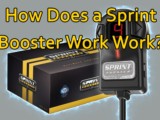How Sprint Booster Works in Your MINI Cooper.
In the old days, the interaction between your pedal pressure and your throttle was immediate. You pressed on the pedal and the throttle cable opens your throttle instantly. You had a direct connection between pedal and throttle.
Today however, your accelerator pedal is connected to a sensor that sends a signal to the ECU (engine control unit). The ECU is connected to a servomotor that operates the throttle in proportion to the input from the accelerator pedal. And because your ECU is “governed” (for various reasons which we’ll go into later), you get a hesitation called “pedal lag.”
But with a Sprint Booster, when you turn it on, it actually remaps the curve that the pedal is producing giving your throttle instant response.
So, What Exactly Does the Sprint Booster Do?
The short answer is, it is an amplifier, boosting the accelerator pedal sensor signal by about 30% which makes the accelerator pedal about 30% more sensitive.
What Exactly Does the ECU Do?
The ECU does a lot of things.
For example it may:
it reduce the pedal sensitivity when driving in reverse.
close the throttle based upon wheel spin, or loss of traction, even if the accelerator pedal is not moved.
limit throttle response in the case of a fault, such as engine overheating.
alter the response of the throttle to the accelerator adapting to the driving style.
Your ECU IS a smart tool, but it sure is a limit on pedal accuracy.
Some Terminology That Seems Confusing
“The ECT system (Electronic Throttle Control) is also known as drive-by-wire yet in conventional throttle systems, the accelerator pedal is connected to the throttle by a cable. You would think then that Convention throttles would be “drive by wire” and not the ECT. But here’s the catch. The “wire” in the ECT is an electrical wire, not a metal cable.
Let's make sure we're showing you the right parts! Please Select your car type Below:









